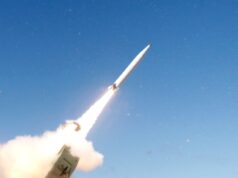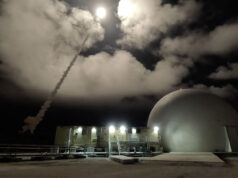An XQ-58A drone recently launched an ALTIUS-600 small drone from its weapons bay.
According to the U.S. Air Force, the Air Force Research Laboratory successfully completed the XQ-58A Valkyrie’s sixth flight test and first release from its internal weapons bay, March 26, 2021 at Yuma Proving Ground, Arizona.
“This test, conducted in partnership with Kratos UAS and Area-I, demonstrated the ability to launch an ALTIUS-600 small, unmanned aircraft system (SUAS) from the internal weapons bay of the XQ-58A. Kratos, Area-I and AFRL designed and fabricated the SUAS carriage and developed software to enable release. After successful release of the SUAS, the XQ-58A completed additional test points to expand its demonstrated operating envelope.”
“This is the sixth flight of the Valkyrie and the first time the payload bay doors have been opened in flight,” said Alyson Turri, demonstration programme manager.
“In addition to this first SUAS separation demonstration, the XQ-58A flew higher and faster than previous flights.”
The XQ-58A Valkyrie is a high subsonic, long-range strike unmanned aerial vehicle being developed by Kratos Defense & Security Solutions in collaboration with the U.S. Air Force Research Laboratory. You can read more about the XQ-58A uncrewed aircraft itself here.
The U.S. Air Force say that this test “further demonstrates the utility of affordable, high performance unmanned air vehicles”.









… and so it will continue with drones deploying drones which deploy drones.Then you will have drones recovering drones. The prize will go to that Country which can do this most effectively at an appropriate price and not take decades doing it
I think the technology is developing so quickly no one has decided to put the advanced technology into serial production if that makes any sense.
Ideally I think we should have gone ahead and built a squadron of Taranis UAV’s and continued to develop them and utilize them as test beds like the US is doing.
Maybe we already are and the government isn’t publishing it but I doubt it.
How are we going to develop Unmanned AEW and refueling if we don’t have a working UAV base aircraft to work off.
Ha……. I believe you have a very valid point….. I also think we are seeing some type of new arms race where each “Side” has all the Ideas but no money to commit before the others do….. sort of like a Cold War of Concepts.
A very pertinent point and thats not a new thing really. If you commit first then your ‘product’ is set on a path that may well be far inferior to something committed to even 5 years later. Now thats not simply overall capabilities, it can be its overall usefulness too (sometimes less is more esp in terms of numbers), as the first has to commit to use scenarios that experience may over time prove were in error. Looking on from the side can often evaluate and make those choices more easily valued … especially if you can break into servers. Therefore timing is everything even as delaying too long can be very dangerous as hypersonic has perhaps recently revealed as the opposition take a big at least potential lead.
true i am worried it might replace our jobs.
The Army, Royal Air Force and Royal Navy will eventually put a lot of trust in drone and battlefield remote equipment which will produce more jobs cuts .
Not just the armed forces, across the economy. But the upshot would be fewer jobs but more productive/higher paid jobs. Which is why increasing the UK population over the years will cause difficulties in the future. We should have done more with the people we had (working smarter not harder).
I don’t think drones ever will. It’s like believing robots will replace soldiers. Not going to happen for a number of reasons. Not least because they can be hacked. At least the pilot would have a manual data kill switch and he could fly the plane manually to get it home or keep fighting if it was hacked. They will always be supplementary. The real debate is, what will the ratio be, 50/50 human pillot, drone?.
Hear hear. I agree with everything you said.
The taranis has been around since early 2010. Here we are 10 years later and everyone is doing what we were already doing. Classic, classic case of British genius being thrown away due to lack of political willpower and funding.
I agree, We could be providing a Taranis type aircraft to all partner nations of the F35 and be building them in the UK.
the norwegians have shown us how to do this with the JSM /NSM and we could have been the world leader in loyal wingmen, I still think we can if we get a move on. Then we do what the yanks do and make it work with Brimstone from the start and they either take it with brimstone or certify it themselves for other types.
Taranis should have been in production by now, we have to stop being so wasteful with our R&D.
Spot on, more so when you see what happened with Azerjaibain and Armenia last October. The side with the most effective drones, coupled with a sensible concept of operations, and an eye to the future, gets the upper hand straight away.
But when will that drone be able to launch a drone? lol
I can see a scenario of flying Russian dolls….after 24 dolls in a doll, the final doll is revealed to the delight and huge applause from defence chiefs!
So by 2040 or even sooner, artificial intelligence will be allowing drones to deploy drone aircraft, drone ground vehicles, and drone naval assets while drone soldiers will become completely autonomous …
At an estimated $2m each (let’s say £2m) for a production run of 100 units surely we should just purchase 100 with the command consoles etc, for £250m and get on with it.
if the MOD becomes an early adopter we can probably get a manufacturing site set up in the UK, but I would only do this if it is economically viable.
this is the perfect platform for the loyal wingman and air refuelling requirements, its flying and pretty advanced. We can mess about and spend £50m on a concept or we can spend £250m on a fleet.
personally I would take the risk, after all it can’t be worse than watchkeeper and we can partner with the US to make it fully interoperable with the F35 force.
Ha…. Another Partner project with the US…. should we just say We’ll buy a third of what we promise now…. or wait a few years till the next Review ?
Ideally I would like us to have done something with Taranis, and the recent announcements are to inform decision making not actually get into production (so another set of expensive trials when we can just get on with it and make do and mend as we go along)
If we can get a fixed price on the X58 and take it on as is at least we have a fleet that is sizeable, can be used in a large number of scenarios and is cheap enough to dispose of or use for target practice when they are of no further use, then we get value today and tomorrow.
only works of course if the company producing really can hit their $2m per unit price for 100 units.
Taranis to my mind was a Design Concept Exercise in Higher thinking and conceptual manufacturing……. The whole project keeps both alive.
Exactly, work on its concept continues no doubt, just as have identical type programmes in the US have been ongoing and developing on various platform/prototypes for nearly 20 years without an actual product yet to enter service. Equally the US despite its massive budgets is still in endless debate as to what it actually wants these drones to be and the only products likely to be given the green light any time soon to do so, will be of the Valkyrie level or refuelling tankers on carriers (with limited stealth/strike/recon abilities), far short of what was originally being worked on. If the US is constantly re arranging the deck chairs on projects like this and as such are not committing to top level potential because they can agree what the capabilities should be, then it really isn’t time for the UK to commit to a Taranis to become a production level entity any time soon. I doubt we will be seeing that before the 30s at the earliest, assuming we see a national project of that high end nature at all.
The overarching problem with this tech is that even if you do have an agreed mission goal, at the very high end the tech advances so quickly and likely affects the platform design/size itself so much, that by the time you fly anything close to producible it is well out of date. Its one of the ‘published’ reasons Northrop have ostensibly pulled out of the Navy program because its much developed/tested platform was, despite being incredibly advanced not transferable to what the Navy is presently committed to.
Car manufacturers produce concept cars all the time. Many never go into actual production but sometimes a part of the concept goes into their next evolved production car. Proof of concept is not an unusual thing to engage in and then with that in hand, it’s back to the drawing board.
It has been designed for the loyal wingman role. It’s quite small- 28ft long 22 ft wide with a 550 lb payload ( per Wiki). So no use for refuelling.
Manufacturer website has slightly larger dimensions with dry weight of 2500lbs and MTOW of 6000 lbs
Fair comment, but once we have these and prove them perhaps we build a much bigger version.
if we can get something that can be printed in a factory in the uk I would be delighted, but in the meantime this is something I would jump on.
it won’t happen, we will spend a fortune on lanca and end up with something not as good probably ( I hope I am wrong)
Building the aircraft isn’t the problem. Its the software. Its always the software nowadays. That isn’t going to get any easier as we move from remote control to autonomous AI driven platforms.
If Watchkeeper taught us anything, its how its possible to take an already proven flying platform, but then still massively overrun on time and cost before getting to something operationally deployable.
drone launches drone…..skynet….just putting it out there is all.
Hang on, I need to go and have a think but don’t worry mate….. “I’ll be Back”……
Viene una tormenta!
Valkyrie. Hmmmm. Don’t let any F-104 get too close!
The XQ-58A is only one of three candidates for the USAF’s Skyborg program. Boeing and General Atomics also have contracts to deliver prototypes. Prototypes are due next month with testing to start in July. Originally, four companies were selected to deliver a prototype; the fourth being Northrop Grumman. But it appears that Northrop Grumman was de-selected or, speculation, given Northrop’s history with the USAF, it has a drone that has been moved into the black world as the RQ-180 was.
In any event, the Skyborg program is on a fast track.
The complexities of these programmes and their history and cancelations only to raise their heads again under a different guise (or project) is often beyond comprehension (beyond making it a full time job to keep abreast). Northrop’s work on the autonomous stealth strike concept could be argued as the most advanced over the years but on the surface it looks like they aren’t immediately (if what you say is correct) openly competing for either the USAF or navy current projects as ironically their designs are it seems too advanced for what is presently required (but may grow into over time apparently, though seems to be a yearly moving goalposts). I suspect, as you suggest their work will resurrect itself, certainly for the navy efforts at some stage in the future while their autonomous system itself has already been demonstrated on other platforms as a demonstrator so has plenty of potential as and when it is deemed central to actual (probably top secret) need.
“Oh machines launching machines! How peverse!”
C3-PO
It will likely become the norm as human fertility goes through the floor… probably as a result of all the damaging chemicals released into the environment by building them.
Gotta be honest, kind of sad that you didn’t get the reference.
The drone just gave birth. haha
Reminds me of this
Must admit to having thought the same thing, but in the context of it being a Russian response with drone program called Matryoshka. They’ll all be hypersonic of course.
The Altius-600 launched from the Valkerie above is often discussed in the context of Air Launched Effects from the FARA and FLRAA platforms as well. One of the two “Small UAS” referenced in the recent RN slide might look a lot like this as a light strike, EO/IR, EW platform with 4+ hour endurance and 440km range.
https://areai.com/altius-600-2/
And still, no word on the Taranis. Every modern nation will have a long range stealth drone carrying bombs and anti-tank missiles while we faff about scrounging for pennies.
Taranis was a demonstrator – ancient history. We have LANCA now.